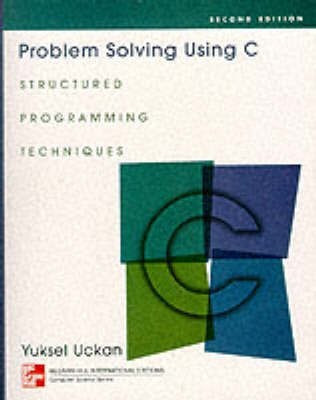Problem Solving Using C - Structured Programming Techniques(English, Paperback, Uckan Yuksel)
Quick Overview
Product Price Comparison
This book is suitable for students with little or no programming background. The complete book can easily be covered in a one-semester or one-quarter introductory course on problem solving. The book's main emphasis is problem solving; the C programming language is used as the vehicle for problem solving. To this end, a sufficient subset of the C language is presented in the book. However the book does not attempt to cover the complete C spectrum but stresses only the features essential to problem solving in the first course in computing. Therefore, this book is not a comprehensive C reference book but a textbook for students who want to learn problem solving using computers, structured procedural programming, and the standard C language. Key Features Early exposure to problem solving techniques and pseudocoding. Early exposure to problem solving techniques and pseudocoding. Chapter 2 ("Problem Solving Techniques") is independent of the C programming language. It focuses on problem solving and elements of software development including requirements specification, analysis, and algorithm design. Chapter 2 ("Problem Solving Techniques") is independent of the C programming language. It focuses on problem solving and elements of software development including requirements specification, analysis, and algorithm design. Software development is stressed throughout the book. After software development is introduced in Chapter 2, it is applied to problem solving throughout the rest of the book. Most example programs include detailed requirement specifications and problem analysis. Then, solutions are designed using the stepwise refinement process and implemented a C programs. Software development is stressed throughout the book. After software development is introduced in Chapter 2, it is applied to problem solving throughout the rest of the book. Most example programs include detailed requirement specifications and problem analysis. Then, solutions are designed using the stepwise refinement process and implemented a C programs. Gradual introduction to pointers. Gradual introduction to pointers. The concept of pointer variables is important in C programming and also one of the more difficult to teach. Rather than introduce pointers in a single chapter, the book introduces this concept over three chapters: 10 ("More on Modular Programming and Functions"), 11 ("Arrays"), and 13 ("Character Data and Strings"). The concept of pointer variables is important in C programming and also one of the more difficult to teach. Rather than introduce pointers in a single chapter, the book introduces this concept over three chapters: 10 ("More on Modular Programming and Functions"), 11 ("Arrays"), and 13 ("Character Data and Strings"). 22 Complete Example Programs provided throughout the book. 22 Complete Example Programs provided throughout the book. With the exception of Chapter 2, every chapter contains one or more complete C example programs based on the concepts and techniques studied in that chapter. These programs are relevant case studies that are often similar to problems encountered in professional programming environments. With the exception of Chapter 2, every chapter contains one or more complete C example programs based on the concepts and techniques studied in that chapter. These programs are relevant case studies that are often similar to problems encountered in professional programming environments. Extensive revision has significantly improved the book. Extensive revision has significantly improved the book. Important revisions include a new chapter on recursion (Ch. 15), getting students to program earlier (now Ch. 1), and a new chapter on file I/O (Ch. 8). Important revisions include a new chapter on recursion (Ch. 15), getting students to program earlier (now Ch. 1), and a new chapter on file I/O (Ch. 8). ┬Ā


